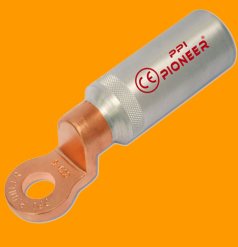Bimetallic Connectors: Ensuring Reliable Electrical Connections Across Different Materials

Strong 8k brings an ultra-HD IPTV experience to your living room and your pocket.
Bimetallic connectors are essential components in electrical systems where two different metals need to be connected reliably. These connectors are designed to facilitate secure and efficient connections between different materials, such as copper and aluminum, which are often used in electrical wiring and equipment. By combining the properties of two metals, bimetallic connectors help overcome the challenges of dissimilar metal connections, preventing issues like corrosion and electrical resistance.
What Are Bimetallic Connectors?
Bimetallic connectors are electrical connectors that combine two metals, typically copper and aluminum, to form a single unit. These connectors are commonly used in situations where electrical systems incorporate both types of materials, such as in power distribution systems, electrical panels, transformers, and electrical devices. Bimetallic connectors allow for a seamless connection between dissimilar metals, ensuring both reliable conductivity and long-term durability.
The bimetallic construction of these connectors ensures that the advantages of each metal are harnessed—copper’s excellent conductivity and aluminum’s lighter weight and cost-effectiveness. The key challenge with mixing metals in electrical connections is managing the difference in thermal expansion and conductivity between the two. Bimetallic connectors are engineered to overcome this, ensuring that both metals work together in harmony.
Benefits of Bimetallic Connectors
Prevention of Corrosion: One of the significant issues when connecting copper and aluminum directly is galvanic corrosion. When these metals are connected without an intermediate layer, corrosion can occur, which impairs electrical conductivity. Bimetallic connectors use a special interface that prevents such corrosion, ensuring reliable performance and longevity.
Improved Electrical Conductivity: Copper is well-known for its excellent electrical conductivity, while aluminum is less conductive. A bimetallic connector combines the best of both worlds, ensuring that the connection between copper and aluminum wiring maintains high conductivity and efficient energy transfer.
Cost-Effective Solution: Aluminum is a more affordable metal than copper, and using it in the right places helps reduce material costs. By using bimetallic connectors, you can benefit from the cost-effectiveness of aluminum while still enjoying the superior conductivity of copper at the point of connection.
Durability and Long-Term Reliability: Bimetallic connectors are designed to be durable, offering long-lasting connections that can withstand high temperatures, vibrations, and harsh environmental conditions. They are ideal for use in outdoor and industrial applications where conditions can be demanding.
Easy Installation: Bimetallic connectors are designed for easy installation, reducing the complexity of electrical setups and ensuring that connections are safe and secure. They are available in various designs, such as lugs and terminals, making them versatile for use in different applications.
Types of Bimetallic Connectors
Bimetallic connectors come in various forms, each designed for specific applications. Some of the most common types include:
Bimetallic Lugs: These connectors are designed to connect electrical cables to other components like circuit breakers, switches, or transformers. They combine copper and aluminum to form a strong, corrosion-resistant connection.
Bimetallic Terminals: Similar to lugs, bimetallic terminals are used for connecting wires to electrical equipment. These connectors are available in various sizes and configurations, depending on the specific application.
Bimetallic Sleeves: These are used to connect copper and aluminum conductors together without the need for additional adaptors or fittings. They are commonly used in power distribution lines.
Bimetallic Clamps: These clamps are used to secure cables in place while ensuring an efficient electrical connection. They are particularly useful in systems that require flexibility in their cable management.
Applications of Bimetallic Connectors
Bimetallic connectors are widely used in industries and applications where copper and aluminum wires need to be connected securely. Some of the key applications include:
Power Distribution Systems: Bimetallic connectors are often used in power grids and electrical substations to connect copper and aluminum conductors, ensuring the reliable transmission of electricity.
Renewable Energy Systems: In solar and wind energy systems, bimetallic connectors are used to link copper and aluminum cables, optimizing the performance of energy systems.
Electrical Equipment: Many electrical devices, such as transformers, circuit breakers, and control panels, use bimetallic connectors to ensure reliable power distribution and prevent overheating.
Marine and Industrial Applications: Bimetallic connectors are used in harsh environments such as marine vessels and industrial machinery, where corrosion resistance and reliability are paramount.
Conclusion
Bimetallic connectors play a vital role in ensuring safe, efficient, and durable electrical connections in systems that involve both copper and aluminum. By preventing corrosion, improving electrical conductivity, and offering a cost-effective solution, these connectors are essential components for industries ranging from power distribution to renewable energy.
Whether you’re in need of bimetallic lugs, terminals, or other connectors, ensure you choose high-quality, reliable products to maintain the integrity of your electrical system.
At Pioneer Power International, we specialize in providing top-quality bimetallic connectors designed to meet the diverse needs of our clients. Whether you're working in industrial, commercial, or residential applications, our bimetallic connectors ensure long-lasting and efficient performance.
Note: IndiBlogHub features both user-submitted and editorial content. We do not verify third-party contributions. Read our Disclaimer and Privacy Policyfor details.


